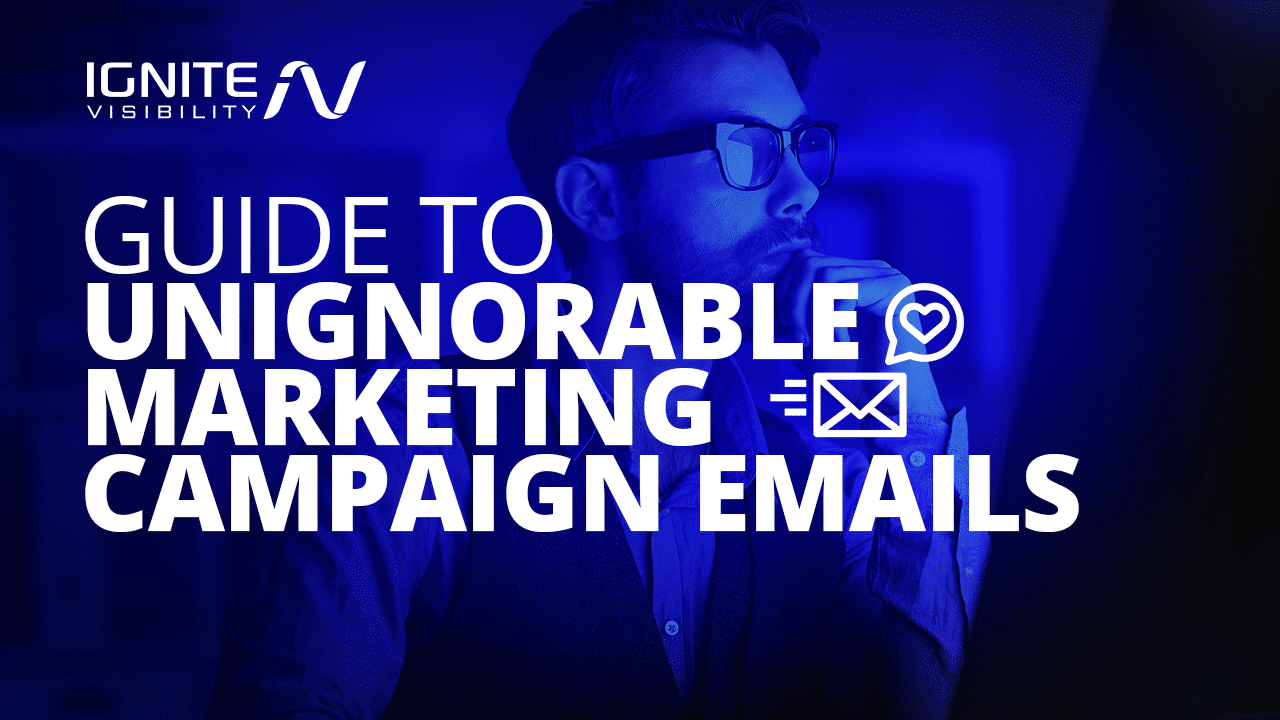
Email marketing will bring in a projected $18B in revenue by 2027. It doesn’t matter how social media, the metaverse, or anything else develops—email marketing is here to stay.
So, what do effective marketing emails look like? How do you reach customers through all the junk in their inboxes?
This guide shows you how brands write killer marketing campaign emails, examples, and the best tools for creating them.
What Are the Benefits of Marketing Campaign Emails?
Here’s why every business needs to know how to write engaging emails:
- Cost-Effectiveness: Email marketing returns $36 for every dollar spent.
- Easy to Produce: You can create stunning email designs easily with marketing software (see below for recommendations).
- Timeliness: By scheduling email marketing campaigns, you ensure they appear at the perfect time. You can even segment your audience by time zone.
- More Leads: Triggered email chains nurture new leads and get them to convert.
- Value for Audience: Routinely providing value to your audience via email establishes you as a thought authority.
- Direct Contact: Nothing—exception for unsubscribes—can prevent you from emailing customers. It’s not a rented platform like LinkedIn and Instagram.
- Website Traffic: Funnel users to your products, blogs, and other pages directly with hyperlinks and CTA buttons. 14% of marketers say email is their top website traffic source.
Rules of Email Etiquette
All marketers should follow these essential email marketing tips, no matter their brand voice:
- Be careful with sarcasm. It’s easy for readers to take sarcasm the wrong way because there’s no body language context.
- No misleading subject lines. Don’t try to force opens with clickbait—it’ll only earn you unsubscribes.
- Check for typos. Grammar mistakes and misspelled words kill professionalism.
- Keep language inclusive. You have all kinds of customers. Don’t offend them with careless remarks.
- Make it mobile-friendly. Nearly half of all emails are opened on mobile.
- Make unsubscribing easy. Let people unsubscribe in a few seconds. It’s consumer-friendly and the law in many countries.
- Verify all links. Broken or misdirected links in your emails could spell disaster.
- Apologize for mistakes. If your brand makes a mistake in an email, don’t be afraid to apologize. You’ll endear yourself to your audience instead of devaluing your brand.
Types of Engaging Email Content
Our inboxes are full of emails. They often follow one of the email marketing templates below:
Welcome Emails
The first email you get after submitting your address is the welcome email. This is your first impression on a subscriber and sets the tone for future emails.
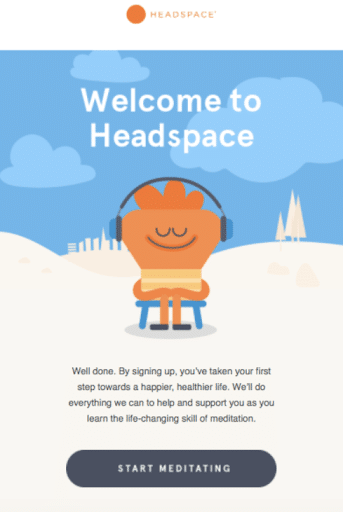
Start your relationship off right with a special offer, a video, or just a warm welcome.
Newsletters
Newsletters are emails sent regularly to subscribers by businesses or individuals. Their job is to build customer relationships by creating brand awareness, sharing knowledge, and promoting new products.
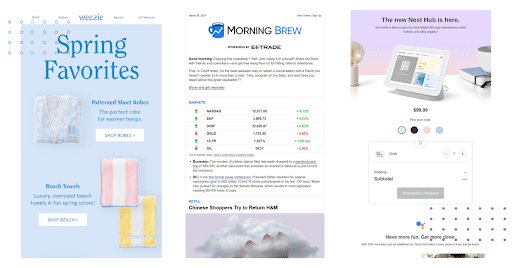
They should include value-centric content like guides, sales, blogs, product reviews, tips, and announcements. You’ll lose their interest if you slam them with low-effort promos.
Surveys
An email survey is a way to collect information from your customers through surveys sent by email. It’s a quick, effective way to get feedback from loyal customers.
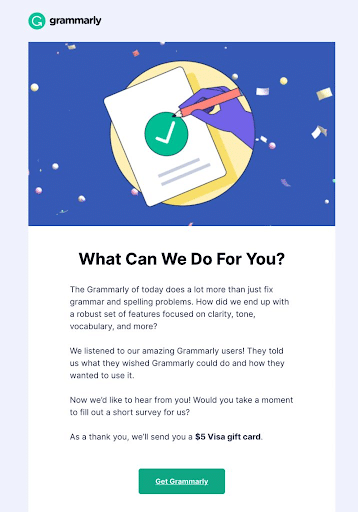
CRM-integrated marketing tools let you send thousands of personalized emails at once.
Be sure to include an incentive like Grammarly does above. Otherwise, your response rates will plummet (people won’t complete long surveys for free).
Loyalty Programs
There are two kinds of loyalty program emails:
- Those announcing a loyalty program to existing subscribers
- Those telling loyalty members about their rewards status and what they can redeem
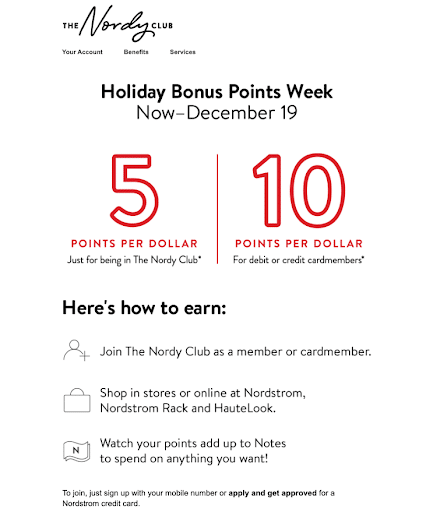
Both inspire people to use your loyalty program more often, leading to more sales.
Testimonials and Success Stories
Regularly share success stories with your email subscribers.
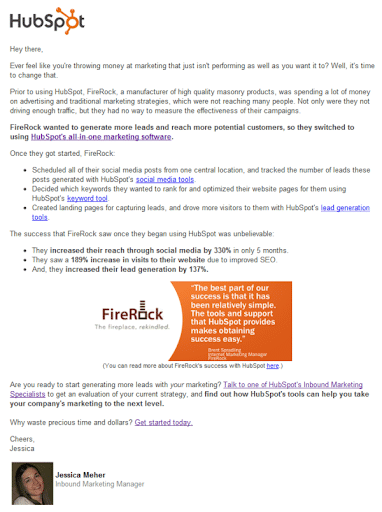
Success stories fuel your readers with confidence about your brand, prompting them to move further down the sales funnel.
Promotions
Most promotional emails just promote something without any subtlety. While customers receive tons of them every day, you can still make yours stand out.
First, always send them a genuinely valuable offer. Instead of just letting customers know there’s a product available, offer a deal.
Email marketing tip: ask yourself, “Would I be excited about this offer?”
Second, don’t send promotions too often. Customer emails should always provide value, and endlessly bombarding them is a one-way ticket to unsubscribe territory (and a bad rep for your business).
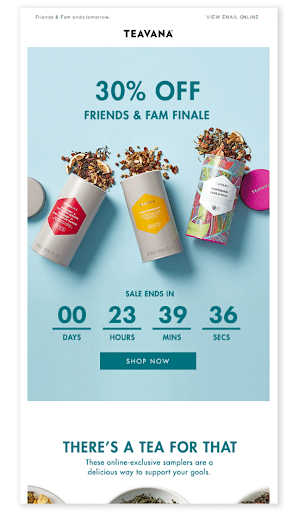
Alternatively, let your audience choose what kind of emails they want to get when signing up.
The Anatomy of a Marketing Campaign Email
An effective marketing campaign email is a well-oiled machine. Here are the cogs and gears working together to drive a revenue engine:
“From” Label
Your “From” label tells subscribers who the email is from.
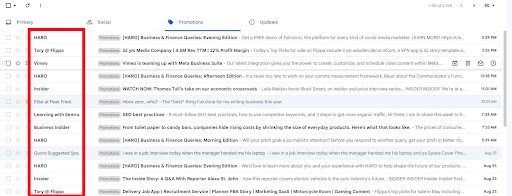
You could use your company name. But when you can personalize the from name, you should. Elect a spokesperson in your company and use their name to show customers they’re communicating with another human, not a brand.
Preheader
An email’s preheader is the text that appears following the subject line. Usually, it’s the first text of the email.

A preheader should be as interesting as possible for the reader. It enhances your subject line and boosts your email’s overall interest.
Subject Line
People usually open emails based on their subject line. Here’s how to write one that gets attention:
Keep It Short
Mobile apps cut off longer subject lines. Shorter lines are also easier to read and process, boosting open rates.
- Short: “50% off, this week only!”
- Long: “We’re having a 50% sale—only one week left!”
Personalize It
78.6% of marketers personalize subject lines. A recipient’s name or company makes an email feel far more personalized and relevant.
- Personalized: “Special offer for you, Jimmy!
- Unpersonalized: “Special offer for you!”
Preview What’s Inside
If your reader requested a PDF or ebook, a preview like “Your offer inside!” makes your email more attractive.
- With preview: “Your ebook is here!”
- Without preview: “Thanks for downloading!”
Keep Promises
If your subject lines are misleading, people will distrust you, leading to lower open rates, more unsubscribes, and a negative image of your brand.
Use Simple Language
Readers skim their inboxes quickly, so use simple language for better understanding.
- Simple: “Our Summer Sale is here!”
- Complex: “The arrival of our Summer Sale is upon us!”
Use Numbers
Email marketing tip: Numbers stand out because they’re more specific and don’t appear often in subject lines.
- With numbers: “Join us at our webinar!”
- Without numbers: “Join 2,000 others at our webinar!”
Don’t Use All Caps
There’s a spammy feel to all-caps subject lines, like 90s-era email viruses.
- Regular: “Join us at our webinar!”
- All caps: “JOIN US AT OUR WEBINAR!”
Greeting/Hook
The email hook is 1-2 sentences carefully crafted to catch the reader’s attention. If you don’t hook your reader, they won’t look at the rest of your content.
Animalz, for example, opens its email with an interesting story. It captivates the reader instantly, making them want to keep reading.
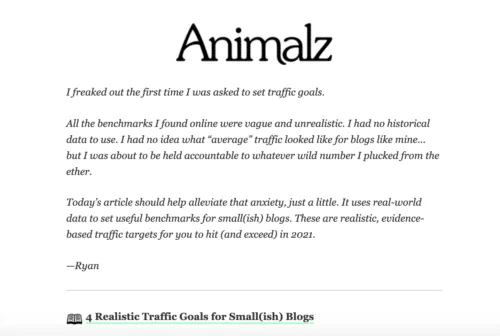
No matter how you present it, every hook starts with the good part.
Don’t hold out on your reader, giving them clickbait like “Read to learn the best sales strategy ever!” Readers won’t stick around to see what you’re saying—they’ll just get bored and move on.
Don’t waste time, just get to the point.
Body Content
Your email’s body contains its main message. Everything’s led up to this, and this is where you wow the reader with awesome value.
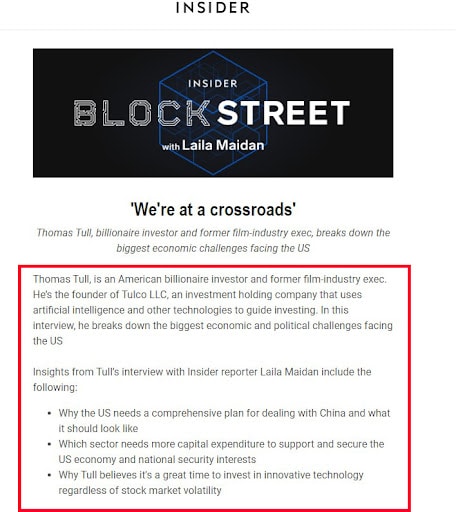
When writing your content, ask yourself, “Would I want to read this if I wasn’t writing it?”
It’s easy for marketers to get caught up in their material and think readers will be obsessed with it as soon as it’s published.
But it’s not that simple. Customers don’t decide to buy your products randomly.
Your content convinces them why what you offer is valuable. It must be laser-focused, dripping with value and lead readers directly to your CTA.
Images
Images are the top media format for 46% of marketers. They’re a quick, easy way to present information in a digestible way.
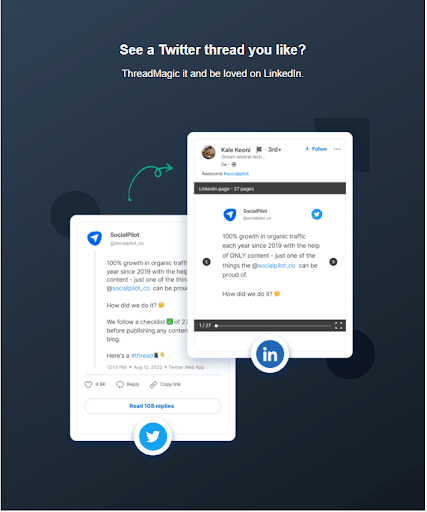
Images add context to your text and highlight the ideas you’re conveying. The brain processes images faster than text, so combining the two makes for a powerful information engine.
It’s not foolproof, though. Follow these guidelines when adding images to your marketing campaign email:
- Include ALT text. ALT texts explain what the image should look like if an email client can’t load it. It also help the visually impaired understand what’s going on.
- Keep file size small. If your images are too large, people may not see them if their Internet connection is slow.
- Keep it relevant. Don’t add images just to add images. Adding images should enhance your content, not distract from it.
- Avoid stock images. Stock images give your content a phony vibe. Making custom images isn’t hard—software like Canva makes it easy.
Call to Action (CTA)
CTAs get readers to take action, usually by clicking a link.
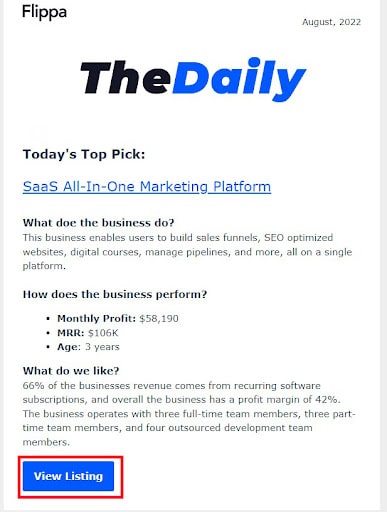
A CTA is the end goal of the email. Once the user clicks it, the job is over.
In fact, you could boil the entire process down to something like:
- The recipient sees your email in their inbox
- Reads “From” label, subject line, and preheader
- Opens the email
- Gets hooked by the first two lines
- Reads the body content
- Clicks the CTA
CTAs are the end goal of every email, so figure yours out before doing anything else. Let it guide your entire email from the subject line to the CTA.
CTAs vary based on industry and end goal, but all good ones have a few things in common:
- They’re friendly. Your CTA should warmly invite readers to complete its goal. Don’t use demanding language like “CLICK NOW.”
- They’re specific. Avoid generic CTAs like “Let’s go” and “Take me there.” Instead, tell your readers what happens when they click.
- They’re short. The ideal CTA is as direct as possible—no more than 3-4 words.
Unsubscribe Link
Unsubscribe links make it easy for readers to stop getting your emails. Not only is it good practice for a consumer-friendly company, but it’s the law in many places.
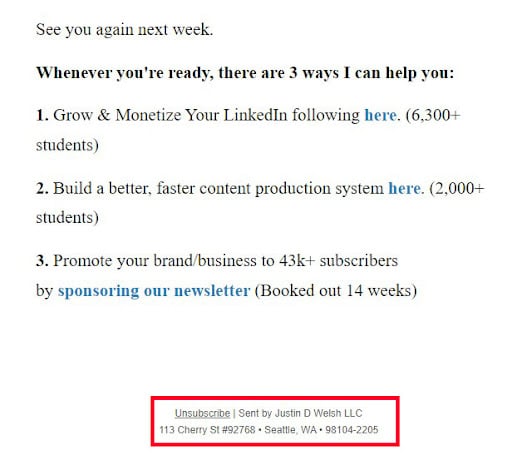
Unsubscribing should be a one-click process. Any longer and readers will get frustrated and block your address, which reports all future emails as spam.
How to Write a Marketing Email: A/B Test Email Content
A/B tests measure how different variations of the same email perform.
When you’ve created your marketing email, make a version B to see how a single change affects engagement. Compare each version with a small audience and see which gets more engagement.
After you’ve found a winner, you can test new variations and optimize them further.
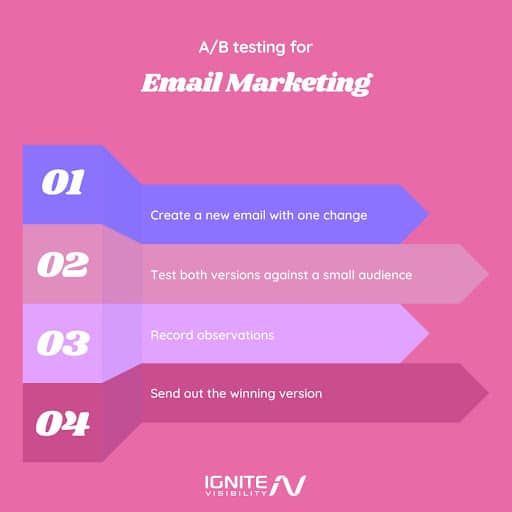
Email Components to Test
Tests aren’t just helpful for optimizing single campaigns—they help you learn more about your audience.
Here are the most important things to test in your email campaign:
Sending Time
The time at which you send your emails makes a huge difference.
Depending on their time zone, your audience might be asleep when your emails arrive. Send at different times and days of the week to see what works best.
A Wednesday noon email may have twice the engagement as a Saturday morning email, for example.
Subject Line
61% of marketers whose emails land in primary inboxes (versus promotion or spam labels) optimize their subject lines. Customers open your emails based mostly on the subject line.
You can test these parts of your subject line:
- Personalization. See how effective adding the recipient’s name, company, or other personal info is.
- Length. Test short and long versions of your subject lines.
- Offers and promotions. See what promotions are most popular with customers by adding them to your subject line (ex. “25% Off” vs. “Free Shipping”)
- Phrasing. Different ways of saying the same thing gets different results. For example, “50% off footballs” might get more engagement than “Footballs are on sale.”
Preheader
Optimizing your marketing campaign email’s preview text can make a big difference. Like subject lines, you can test length, phrasing, and personalization.
You can also test if a preheader works at all. Some marketers have found not having a preheader boosts open rates.
Content
Content works like a car, with different parts making it perform better. You can test things like:
- Positive vs. negative voice. Emotion plays a big role in how your writing captures the reader’s attention. Campaign Monitor increased their email conversions by 22% with a positive tone.
- Formatting. How you format your text (spacing, bold, italics, etc.) affects readability and comprehension. A big text block won’t get read, but mobile-friendly spacing will.
- Length. Length doesn’t have a right or wrong answer. Some audiences like long texts, others like short ones. A/B testing will reveal the best options for your subscribers.
Call To Action
CTAs are the end goal of every email, so testing them is crucial. Test things like:
- Color. Depending on the emotion they convey, and how well they contrast, different colors get different engagement.
- Copy. Don’t use generic phrases like “Buy Now.” Be specific (while still being brief and concise).
- Shape. Changing the shape of your CTA button can increase engagement. While rectangular shapes are the most popular, try different shapes (hexagons, rounded corners, etc.).
Best Email Marketing Tools
Still wondering how to write engaging emails? Successful marketing starts with effective tools. The wrong software limits your creativity and technical freedom.
You’re looking for full-featured, flexible tools with top-quality support. Here are the best options out there:
Omnisend
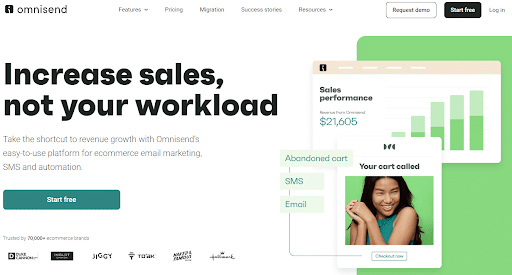
Omnisend is a full-stack marketing platform aimed at ecommerce brands. It lets you automate email and SMS campaigns with zero coding.
It includes fully developed templates for welcome series, cart abandonment, and more. You’ll also find features like:
- Pop-up and sign-up form creation
- Audience segmentation
- Web notifications
- Retargeting contacts with ads
- Campaign revenue analytics
Sendinblue
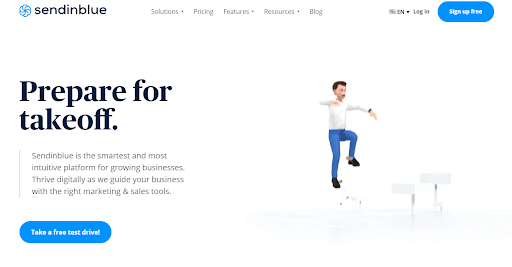
With Sendinblue, you can market via email, SMS, and web chat. It’s CRM-integrated, so all your customer interactions stay consistent across each channel.
Its sleek and user-friendly interface is among the best in email marketing. Its free plan also offers a generous free 300 emails a day, perfect for smaller businesses.
Other features include:
- Sign-up forms
- Landing pages
- Extensive template library
- Facebook ad tools
- Developer-friendly email API
- Extensive automation tools
ConvertKit
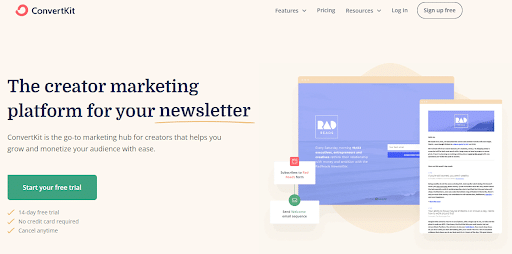
Next is ConvertKit, a tool helping creators of all sizes monetize their audiences. Thanks to its stellar templates, you can make landing pages, forms, and emails in a flash.
A surprisingly generous free version makes it a great choice for smaller creators.
ConvertKit is also known for other features like:
- Extensive integrations (Shopify, Teachable, Zapier, and much more)
- Drag-and-drop email designer with personalization tools
- Highly-customizable automations
- Advanced analytics
Best Marketing Email Examples
These email marketing templates illustrate the principles discussed above:
Dick’s Sporting Goods
Dick’s Sporting Goods uses images, personalization, and a sense of urgency to create an offer customers can’t refuse.
With huge lettering and a countdown timer in the upper right corner, Dick’s makes you feel like you’re missing out on a great deal. Free shipping and one-hour pickup sweeten the offer.
They’ve also personalized the email with the recipient’s name and loyalty card info.
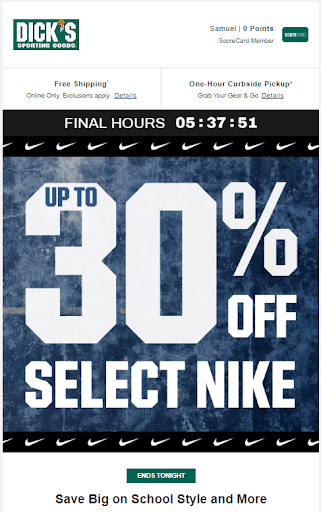
Postmates
Using striking imagery and a 60% offer, Postmates seeks to lure customers back who haven’t bought in a while.
Check out the brief copy and succinct hook, followed by a clear CTA. In this case, less is more.
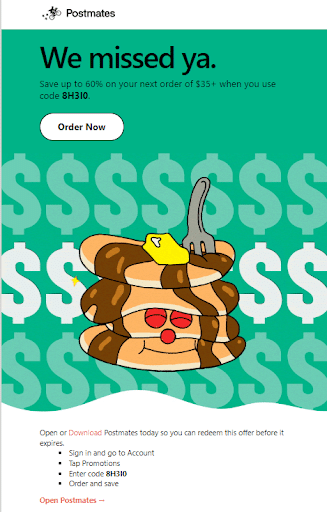
SEMRush
The Semrush newsletter is straightforward. It lists each blog post shared in the newsletter like a table of contents, so readers can skip straight to the meat of the email.
Each blog post has a brief summary and a compelling CTA. While it could have been more specific, it’s clear where the reader is going if they click.
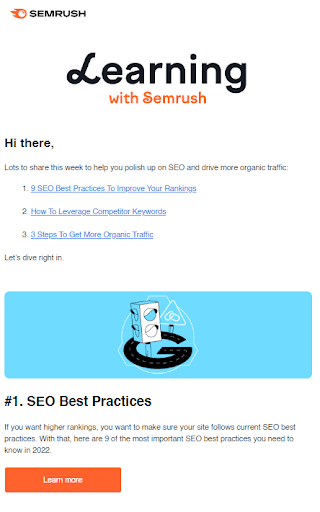
That’s How to Write Engaging Emails
Email marketing isn’t that hard once you break it down.
You need to learn email etiquette, the parts of effective design, and how to A/B test your material. From there, you just need a powerful email marketing platform to create your campaigns.
With practice, you’ll be a pro at sending marketing campaign emails. Start slowly and test along the way.
